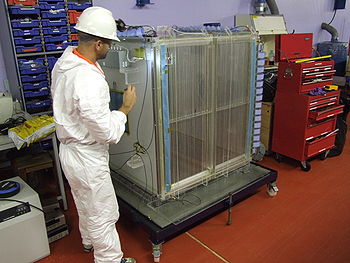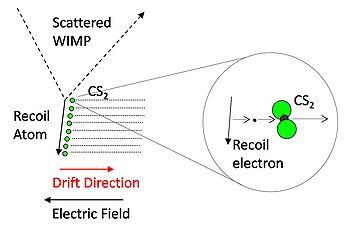
Directional Recoil Identification From Tracks
Encyclopedia

Time projection chamber
In physics, a time projection chamber is a particle detector invented by David R. Nygren, an American physicist, at Lawrence Berkeley Laboratory in the late 1970s...
(NITPC) designed to detect weakly interacting massive particles (WIMPs) - a prime dark matter
Dark matter
In astronomy and cosmology, dark matter is matter that neither emits nor scatters light or other electromagnetic radiation, and so cannot be directly detected via optical or radio astronomy...
candidate.
There are currently two DRIFT detectors in operation. DRIFT-IIb, which is located 1100m underground in the Boulby Underground Laboratory at the Boulby Mine
Boulby Mine
Boulby Mine is a site run by Cleveland Potash, located just southeast of the village of Boulby, on the northeast coast of the North Yorkshire Moors in Redcar and Cleveland, England. It is Europe's second deepest mine at —Pyhäsalmi Mine in Finland is even deeper, being 1,448 metres deep—producing...
in North Yorkshire, England, and DRIFT-IIc, which is located on the surface at Occidental College
Occidental College
Occidental College is a private, coeducational liberal arts college located in the Eagle Rock neighborhood of Los Angeles, California. Founded in 1887, Occidental College, or "Oxy" as it is called by students and alumni, is one of the oldest liberal arts colleges on the West Coast...
, Los Angeles, CA, USA.
The DRIFT collaboration ultimately aims to develop and operate an underground array of DRIFT detectors for observing and reconstructing WIMP-induced nuclear recoil tracks with enough precision to provide a signature of the dark matter halo
Dark matter halo
A dark matter halo is a hypothetical component of a galaxy, which extends beyond the edge of the visible galaxy and dominates the total mass. Since they consist of dark matter, halos cannot be observed directly, but their existence is inferred through their effects on the motions of stars and gas...
.
WIMP Detection
There are numerous experiments worldwide attempting to detect the energy deposition that is expected to occur when a WIMP directly collides with an atom of ordinary matter. Ultra sensitive experiments are required to detect the low energy and extremely rare interaction that is predicted to occur between a WIMP and the nucleus of an atom in a target material. The DRIFT detectors vary from the majority of WIMP detectors in their use of a low pressure gas as a target material. The low pressure gas means that an interaction within the detector causes an ionisation track of measurable length compared to the point like interactions seen in detectors with solid or liquid target materials. Such ionisation tracks can be reconstructed in three dimensions to determine not only the type of particle that caused it, but from which direction the particle came. This directional sensitivity has the potential to prove the existence of WIMPs by their distinct directional signature.Detection technology

Carbon disulfide
Carbon disulfide is a colorless volatile liquid with the formula CS2. The compound is used frequently as a building block in organic chemistry as well as an industrial and chemical non-polar solvent...
(CS2) gas. It is predicted that WIMPs will occasionally collide with the nucleus of a sulfur or carbon atom in the carbon disulfide gas causing the nucleus to recoil. An energetic recoiling nucleus will ionise gas particles creating a path of free electrons. These free electrons readily attach to the electronegative CS2 molecules creating a track of CS2- ions. A cathode
Cathode
A cathode is an electrode through which electric current flows out of a polarized electrical device. Mnemonic: CCD .Cathode polarity is not always negative...
at -34 kV in the center of the gas volume produces a static electric field that causes these negative ions to be drifted, whilst maintaining the track structure, to the MWPC planes at the edges of the detector.

